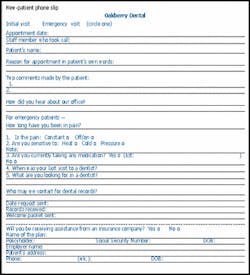Keeping information about patients in a central location will improve patient retention and marketing efforts.
by Janice Hurley
It is a constant challenge among doctors and staff to make our patients feel special. Numerous staff meetings are devoted to customer service. We know patients have a choice when selecting a dentist. Established and new patients alike want to feel like we listen to them. They give us important pieces of information that the whole team needs to know to serve them best. This information should be no secret! It must be shared to provide your patients with the very best.
Doctors who hire dental consultants want to provide optimum care for their patients. What often is missing, though, are the specifics for each team member's individual role. This is an area where we all have the best intentions, but may find ourselves lacking. In this article, I will give you an abbreviated version of the systems I use with my clients to promote excellence in the areas of information retention and usage. These systems benefit both the practice and the patient.
I attended a Frank Spear course recently where he stated that "money is power." I agree. I think he also would agree with the well-known adage that "information is power." In our business, the information we gather piece by piece from our patients is extremely valuable in patient retention and marketing. The challenge is deciding as a group where to keep this information. It needs to be stored in a central location. Only when everyone in the office knows where to access this information can it be used with the greatest results.
I'll start by relating a personal experience. As you read through the course of events, ask yourself what systems are in place in your office to prevent this from happening to your patients.
An "oops" experience
My general dentist recommended that I see a periodontist for a possible tissue graft. I had been missing tooth No. 6 for more than 30 years, and tooth No. 5 had responded to the added stress with tissue recession. My dentist referred me to the "top" periodontist in our area. He had recently appeared on the cover of a well-known periodical for running an insurance-free practice. My confidence was high that I would receive the best care.
We had our initial consultation. The office was beautiful. The doctor was confident and enthusiastic about his work. He quoted a $1,300 fee, which included my professional discount. I took the next step and made my surgery appointment. Up to this point, I think the periodontist would be proud of his team's efforts. I left his office believing that I was in good hands.
My next appointment was scheduled to take place in about three months. Neither of our schedules allowed it to be any sooner. Two weeks before that appointment, I learned that one of my children, who was away at college, needed a rather large sum of money, and she needed it immediately. I called the periodontist's office and apologized for having to reschedule. I explained that, due to finances, I would like to postpone my appointment for another month. I gave them two weeks' notice, and I was honest about the circumstances. It was not the best scenario for the office, but certainly not the worst.
The person who answered the phone was noticeably displeased. I asked if I might reschedule then to reserve a spot within the month. She said the doctor's schedule wasn't in front of her and that she would get back to me. I reviewed the three different phone numbers where she might contact me. Weeks went by. I left several messages suggesting possible dates for an appointment. I finally called the office during business hours and rescheduled. When I asked if there was a particular reason why my phone calls hadn't been returned, the staff member said she "had no idea."
This interaction planted the first seed of doubt about my upcoming visit. "No biggie," I told myself. "It happens to all of us." No one appreciates a patient who cancels, and all of us have forgotten at one time or another to follow through on messages left on an answering machine.
When surgery day arrived, I was the only patient in the reception room. Three different staff members leaned over the counter to ask if they could help me. No one had been at the front desk when I arrived, and none of the team members had heard the others ask me if they could help. I tried to picture their appointment book with just one name on it (mine) for a 9 a.m. surgery. I knew they all meant well, but it was the first indication that no one really knew who I was or what I was scheduled for.
I was taken back to the operatory, and everything went well there. The back-office team definitely knew what I was there for. The tissue graft from my palette was painless; I was very pleased with the doctor's obvious expertise. What did not help me to relax, though, were his never-ending comments to his assistants about what they were doing wrong. I didn't need to know that one of them had threaded the needle backwards three times. I became anxious and uncomfortable for the staff. They obviously fell short of his expectations. As a patient, lying there in the chair, my confidence ebbed away with each criticism.
The following week, my general dentist received a letter thanking him for his referral. It stated that my implant went well, and that we could expect excellent results. Oops ... the wrong procedure was listed.
Unfortunately, the graft failed within the first three days and never gained the blood flow it needed. I gingerly looked in the mirror every 20 minutes to see if the tissue that now looked like a piece of white bread would cooperate. I called the periodontist's office and explained my situation. I apologized, knowing that we would have to use additional office time to redo the procedure. As a consultant, I hated that I might eventually be a "redo" on the books. They asked me to come in to evaluate what had happened.
The assistant began our conversation by cheerfully asking, "So, how is everything? Everything going great with your surgery?" I repeated the details of my situation. When she left, the doctor came in. I repeated the details. He responded by saying I must have brushed too hard with my toothbrush. I was not aware of that ever happening, but I know we both wished the procedure had been successful the first time.
We rescheduled. I received another set of prescriptions to be taken before my surgery.
I returned for my appointment. The first assistant said, "Are you on any medications?" I told her I was only taking the presurgery medications that they had prescribed. Her response was "Well, that's OK if you're taking them. If not, that's OK, too." I was confused. My anxiety level increased.
The procedure was not one I wanted to repeat twice. It only took the assistant's comments that she didn't know what kind of medications I was supposed to take to make me feel that maybe everything wasn't as it should be. I had brought a headset along to block out any discussion during the surgery, but I wasn't sure about the need for it now.
What a different experience being in the patient's chair! I had anxiety in areas that I never thought I would have. I had always been very comfortable in dental offices before. What was different about this one? It was the lack of communication in sharing patient information. I was hearing wrong information about me being repeated among the staff members, and I was having to repeat information that I had previously given the dental office.
In the end, my experience was beneficial. The periodontist solved my recession problem, and I recommitted myself to helping team members understand the importance of their role in helping patients to relax. It is better to say nothing at all than to ask patients to repeat information or comment incorrectly on their situation.
All the work we do to get patient information in a central location is worth the effort. A patient's confidence often is weakest at the beginning of the relationship, so reviewing his or her specifics is crucial. It ends up being both free marketing and a practice builder.
So, how well is your office prepared to avoid the several "oops" experiences that I had? Here is a solution for offices with computers.
The new-patient phone slip
The new-patient phone slip is your first patient communication tool. Our phone slips are designed to focus on the patient's chief complaint or main interest. The insurance information is last. We complete a phone slip for every new patient who makes an appointment for a comprehensive exam or an office visit. Phone slips are made for existing patients' office visits who will have unknown treatment scheduled later.
This phone call should be taken by the account executive, not the patient coordinator, who handles day-to-day patient flow. These conversations can be very time-consuming; the team member who schedules appointments and asks for payments doesn't have enough uninterrupted time. This form is simply a means to collect patient information. The conversation should flow smoothly in a relaxed manner, with the patient's questions and areas of interest taking precedence over anything we wish to talk about. The patient should not get the feeling that we are asking stock questions. Let the conversation flow naturally, with the account executive gently guiding the patient into important areas as the patient feels comfortable.
The next step is for the account executive to enter the patient's information into the computer and then follow up on verifying eligibility and benefits. The new-patient phone slip is filed with other slips for patients with upcoming appointments. Anyone who needs to contact this patient would read the information first on this slip to be aware of details specific to the patient's situation.
Before the patient arrives
The assistant reads the phone slip during the morning huddle to give everyone some background information on the new patient for the day. This is a chance for everyone to become familiar with the patient's circumstances. All team members are aware of the patient's appointment time and can anticipate what their involvement will be.
When the patient arrives
The patient will have filled out the patient-information materials prior to the appointment (or upon arrival, if necessary). The assistant highlights important health history and dental experience information. She reviews the patient's answers to all of the questions. The highlighted areas indicate items that either the patient thought were important to share or areas you know will impact the patient's treatment.
The assistant now has access to the phone slip and the patient-information forms. She familiarizes herself with this material before she goes out to greet the patient. Then, she brings the patient back and starts the conversation with either something learned from the phone slip or the patient's paperwork.
The assistant could begin with the patient's reason for calling and one or two of the details the patient shared on the initial phone call.
For example: "Joanne tells me you're interested in getting your teeth cleaned. She said you are looking for a dentist who will take your insurance and one who is close to where you work."
Or: "I see that it's been about a year-and-a-half since you last saw a dentist and that going to the dentist is not your favorite thing. You didn't share a specific bad experience you've had, but can you think of any specific aspect about going to the dentist that makes you uncomfortable?"
With these comments, you show the patient that the initial questions were asked for a reason — that filling out the paperwork was not just a waste of time and that you have read and care about what he or she said.
Patients then will talk more about topics you have just brought up and feel relaxed enough to share additional information. When they learn that someone really listened and that you are working together as a team, they often relax much more than when they are forced to repeat details about their situation to several staff members.
The assistant continues the interview, making notes on a patient-interview sheet. This sheet has a predetermined series of questions with blank areas for notes and responses. Conduct a relaxed conversation so trust can build. Don't let the patient think you are just reading down a list of impersonal questions. The assistant might respond with, "That's good to know; I'll make a note of that," or "I'll tell Dr. Coeler about that. She'll want to know" — anything to communicate to patients that their stories will not have to be repeated and that your team truly listens.
When the doctor arrives
It is now the assistant's turn to introduce the doctor and summarize what the patient said that was important. The doctor continues the interview, and the assistant makes notes either in the chart or on the computer.
The crucial point now is taking the most important information and entering it in one location on the computer. Dentrex has a "Patient Profile" section where you can customize your entries. Many of the offices I work with have a "Patient Profile Template" in this section, which saves data-entry time. The patient's answers are entered next to the standard questions asked earlier. This section has plenty of space to add additional information. It is usually the assistant who summarizes the information and writes it up.
Before a consultation appointment, the doctor can review this important information, confidently starting the conversation with: "You told me it was important to ..." and "We discussed that, with your last dentist, you experienced ..."
Repeating what the patient has said is important and allows the patient to feel like he or she is in control.
At the hygiene appointment
The hygienist can access the patient-profile sheet in the chart or on the computer. She can start her interaction with something from that sheet or additional clinical notes. It doesn't matter what is reviewed — only that it is accurate. Preferably, it should be a subject that is of interest or pertains to the patient and your care for him. A hygienist can quickly look at a routing slip or a computer screen (at chairside) to know when the patient's last FMX or bitewings were done. It is much more assuring for the patient to hear, "Brenda, we took four diagnostic films back in July of 2000. We will be taking another four films today to update the information for Dr. Coeler," instead of, "Did we take X-rays on your last visit?"
Who should contribute to the information log?
Anyone can and should contribute to the patient-profile section. Every team member who comes in contact with the patient may hear crucial information. The doctor will hear important news during the consultation appointment. Put these important points in a central spot.
Give recognition and praise for all valuable entries. The use of this information in communicating to patients what we have heard and remembered is a real practice builder. We don't need to rush toward getting more new patients if we are not set up to handle the ones we have.
An easy system
The written information is only as good as the number of times it is read by team members to familiarize themselves with the patient's situation. The old system where a patient's personal dental information was sandwiched in between clinical notes in the chart was too time-consuming to digest. No one has time to read all of the chart entries and weed out which parts are important to the patient. Now, with computers everywhere, you can quickly add what is needed to one central spot. Typed notes are much easier to read. Having patients feel like you really know them and are familiar with their dental history is only a couple of mouse clicks away. It takes just minutes to review centralized notes. Any "you'll never have to tell us twice" office is an office I'd like to go to.
Another "oops" experience
Here's another of my personal experiences. My daughter, Signe (a Norwegian name which is a little tricky to pronounce), was quite the track athlete at her high school. She came up lame (literally) after one particular meet and needed to see a doctor. She was particularly concerned because she had qualified to run at the state finals, but was in no condition to do so. Unsure of what her chances were to compete, she wanted to get a diagnosis and treatment recommendation as soon as possible.
We went to one of the orthopedic groups in our area. They asked us all the usual questions over the phone. We got an appointment quickly, because I had worked with this office in the past. (I had not worked there long enough to make things run smoothly, but long enough to get an immediate appointment!) On the initial phone call, after I had reintroduced myself to the staff, I explained how upset Signe was about her condition and that competing was very important to her.
When we checked in, they asked all the same questions I had answered the day before, and they mispronounced Signe's name. When the medical assistant took us to the back, she asked all the questions again and mispronounced Signe's name again. When the assistant left, the orthopedic surgeon entered and told me how good it was to see me and asked all the same questions again and mispronounced her name again!
The doctor made a diagnosis, recommended treatment, and we left. Signe was visibly upset. She said she had no confidence in this office. "That can't be one of your offices, Mom, because they are so disorganized. I don't think he knows what he is talking about." A bit of a dilemma: The patient didn't have confidence in the doctor. I knew he had an excellent reputation, but the speed of her recovery would partially depend on her following his advice.
I made an appointment with another orthopedic surgeon, a personal friend, who had never been my client but at least knew how to pronounce Signe's name! He gave her the same diagnosis and the same recommended treatment, but never once did we have to repeat our information. We weren't treated any different than the rest of his patients. We filled out necessary forms just like everyone else. We waited in the reception area for 45 minutes like everyone else. But the level of confidence that Signe had with this office compared to the first was like night and day. She never said she noticed specific differences in the two offices, but you would have thought one doctor had told her to observe bed rest and the other had told her she could walk on water! As you can see, our patients' confidence in the recommended treatment often is established long before the doctor enters the room.
A plan of action
Here are some guidelines to make our system more than just a good idea:
- Identify each common point of shared information.
- Recognize the value of reviewing this information.
- Agree on a central location to store patient information.
- Decide when and where you can input this information.
- Time how long it takes you to review the data in a typical patient file.
- Give positive feedback to all team members as they start the information-gathering/logging process.
Most of you don't need 50 new patients each month to fill your schedule. You just need the patients you already have to trust that you will take good care of them. Patients share great insights about what is important to them. They tell us in different ways and at different times. It is worthwhile for the whole team to choose a location where important patient information should be kept. It should be part of each team member's job description to review this information before interacting with a patient. When you know what you are talking about, you actually have to talk less.
Staff job descriptions address specific responsibilities of individual positions and also the interrelationship of jobs within the team. With each team member knowing what role the person before her has in gathering and storing patient information, this interdependency eliminates duplication of effort.
I have great-looking tissue on tooth No. 5, and the "top-of-the-line" periodontist still prides himself on having the most professional office on the West Coast ... and it may well be. But all of us benefit from remembering situations where we were the patient. It's enlightening to be in the patient's shoes. We can take our experiences and compare them with how our own in-office systems are constructed to avoid making patients feel unimportant. Listening is free, and patients love it when you listen.








